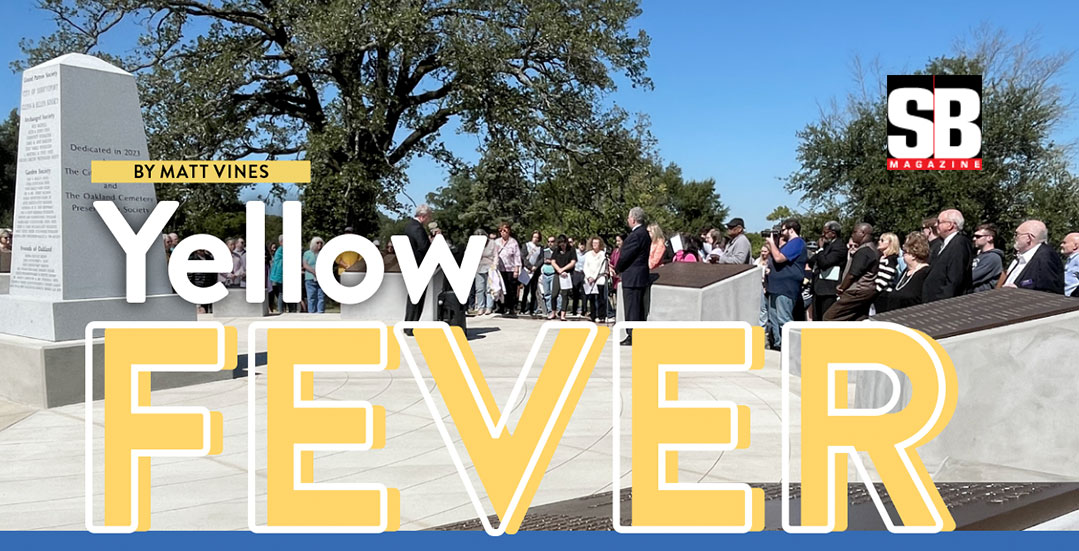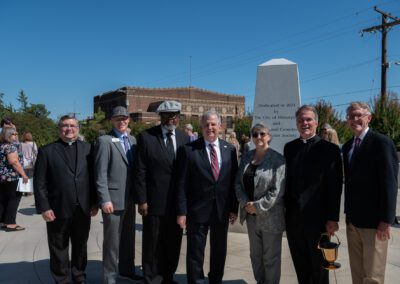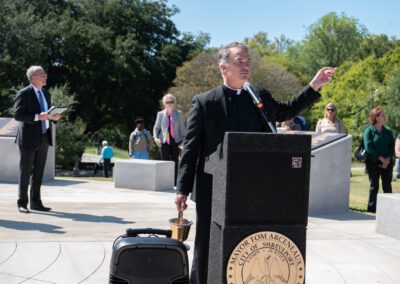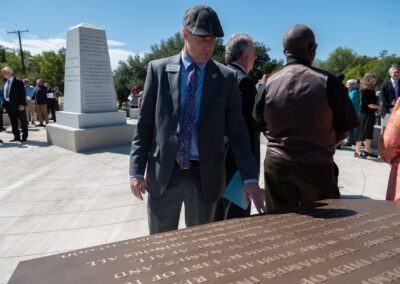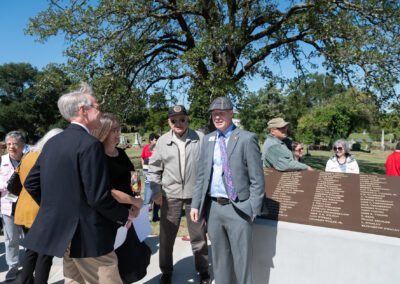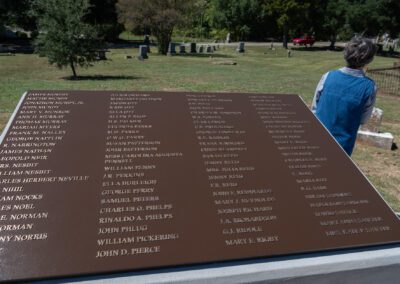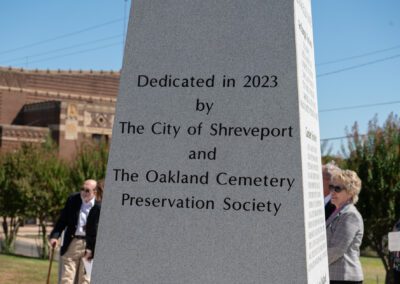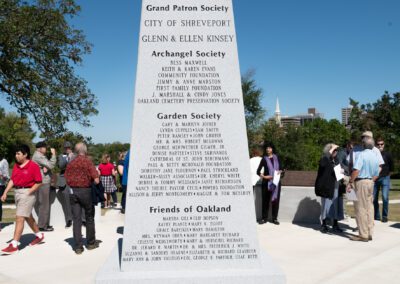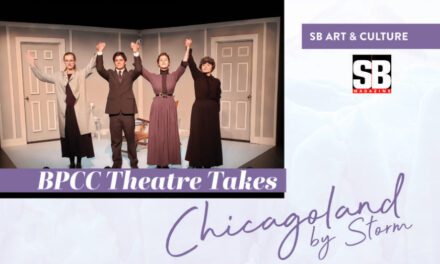“We no longer have funerals. People are blotted out of existence.”
Suburban life is not for the faint-of-heart. The house needs to be maintained. The yard has to be mowed, mulched, weeded, pruned and planted. Sure, you can pay someone to do this, but that costs money and time. And while it’s true that it can be satisfying to tame your tiny slice of the planet, it can also get old. Real old.
That was an observation made in the upstart Daily Times (now the Shreveport Times) near the height of the Yellow Fever Epidemic in 1873.
That epidemic killed one-quarter of Shreveport’s population in the third-worst yellow fever epidemic in U.S. history. More than 1,200 died in a 12-week span between August and November of that year.
It was a perfect storm.
A virulent strain of yellow fever that floated from Cuba and the Mississippi River to the Red River sacked a booming Shreveport town built on riverboat and land commerce.
Because Shreveport was a rapidly growing town with an influx of immigrant populations that hadn’t been previously exposed to yellow fever, more than 1,200 people (approximately 25 percent of the town’s population) died in the third-worst Yellow Fever epidemic in U.S. history.
“The Daily Times (now The Shreveport Times) was a year into publication, and it got to where all they could do was publish the daily death records,” said White, an LSUS history professor. “Shreveport was a nexus of trade on the Red River and on the Texas Trail. Any time you go undergo such a dramatic population loss, it changes the town. While that trade helped bring yellow fever to town, that trade also allowed Shreveport’s population to double seven years later by 1880.”
But before the breakthrough after the epidemic, a quarantined Shreveport faced images of wagon carts picking up the dead headed for a mass grave burial.
Although the science and medical community didn’t know at the time, mosquitos were the cause of yellow fever.
However, there were observations being made about the worst of the outbreak being near standing bodies of brackish water, ideal for mosquito breeding.
Shreveport’s Silver Lake and standing water in St. Paul’s Bottoms provided fertile ground. One of the wettest summers on record contributed to a mosquito explosion.
The daily death rate became so high that funerals could no longer be carried out, and the City of Shreveport buried more than 800 of yellow fever victims in a mass grave in City Cemetery (now Oakland Cemetery).
For 150 years, those in the mound weren’t named.
But two LSUS history professors were key cogs in dreaming up a memorial that names 740 of the buried.
That memorial was unveiled Saturday, October 7, 2023, as a highlight of the months-long commemoration of the epidemic 150 years ago, providing a tribute to those that were previously not memorialized.
Seven large plaques with the names of the fallen circle a tall gray obelisk on top of the mound.
“It’s truly wonderful to see such a large group of people honoring a large group of people,” said Shreveport mayor Tom Arceneaux to a gathering of about 200 at the memorial. “For 150 years, there’s been no dedicated memorial to offer a fitting tribute to these people, and today, we correct that oversight.”
Religious leaders from the seven existing Shreveport churches and temples in 1873 prayed for the victims amid thoughts of being “united by our humanity.”
Leaders from the Antioch Baptist Church, the B’nai Zion Temple, the Church of the Holy Cross, the Catholic Diocese of Shreveport, First Baptist Church, First Methodist Church, Holy Trinity Catholic Church, Little Union Baptist Church, and St. Mark’s Cathedral offered prayers and reflections.
“The people buried here come from all walks of life – they are buried here without regard to social status, to religion or race,” said Paul Strickland, president of the Oakland Cemetery and Preservation Society. “This memorial honors the people buried here from the 1873 epidemic but also honors earlier victims of yellow fever.
“There were so many people involved in this project, but I don’t know if any of this comes to fruition without Dr. Cheryl White.”
White, an LSUS history professor, spearheaded the committee that planned the memorial and the commemoration events happening this fall. The memorial took two years to plan and fundraise and six months to build.
White said the epidemic was the “most transformative event in Shreveport’s history” earlier Saturday in a symposium titled “Yellow Fever: 150 Years Later.”
Fellow LSUS history professor Dr. Gary Joiner, who is chair of the history department, led the research to name the souls buried in the mound.
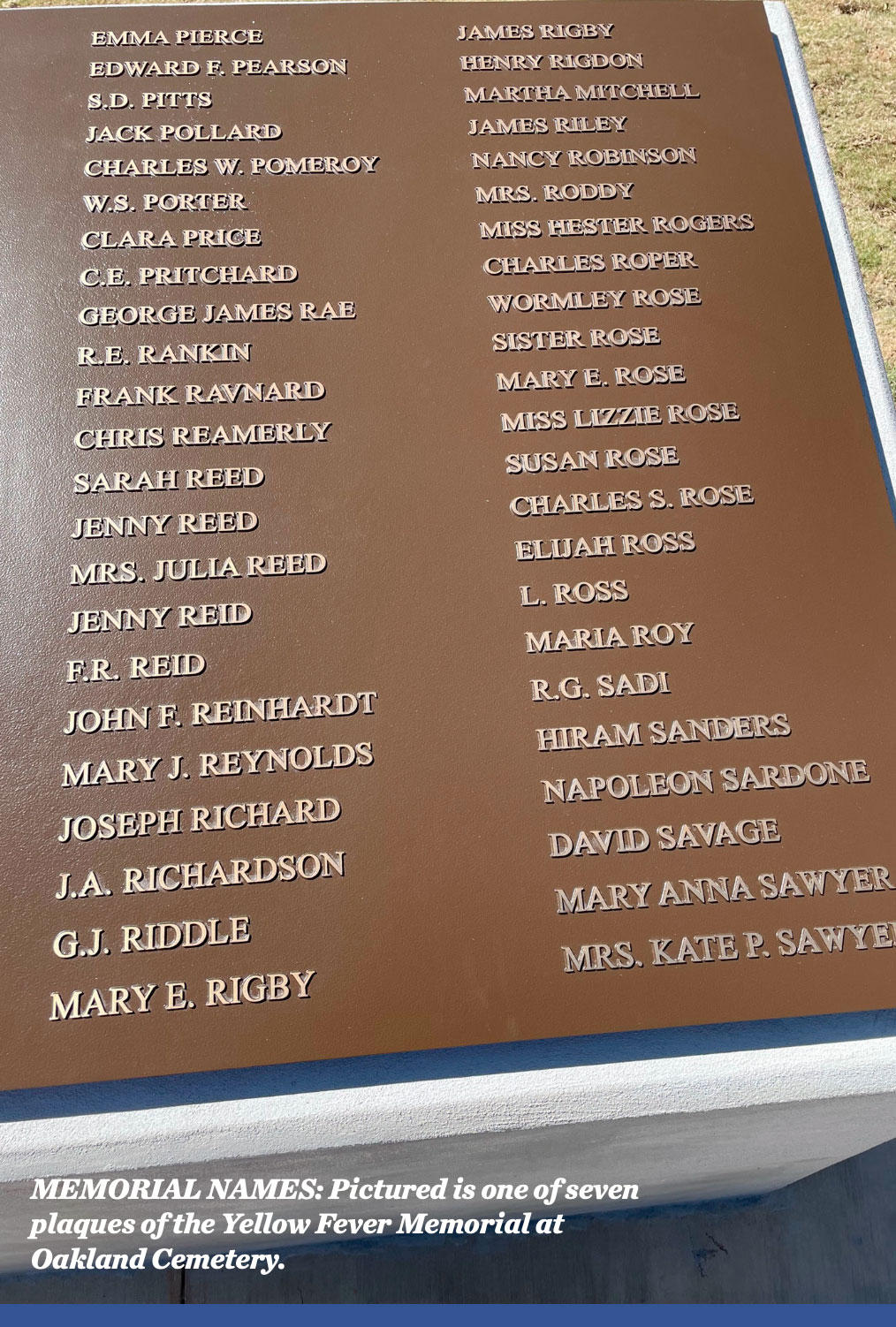
Fellow LSUS history professor Dr. Gary Joiner, who is chair of the history department, led the research to name the souls buried in the mound.
Joiner used the daily reporting from The Daily Times, a crude 1906 map of Oakland Cemetery, death cards housed in the Northwest Louisiana Archives, and a dash of logical creativity to name about 740 of the approximately 800 buried in the mound.
He and a group of students started work in 2006 as they mapped out Oakland Cemetery and identified all known persons buried in actual graves.
While The Times did publish a daily death report, the newspaper didn’t have complete records because the epidemic affected their own staff.
And because Shreveport, a bustling commerce town, didn’t want to shut itself down at the onset of the epidemic, the earliest deaths were recorded as something other than yellow fever.
“There was a baby who died because of ‘teething,’” Joiner said. “Another died of breakbone fever, which was a thing but that wasn’t the cause of death in this situation.
“If you just read the daily list of the dead, you’d be missing tons of people. But there were society columns and other stories that mentioned people dying who weren’t in the official list of the dead.”
Joiner built a database of those who died – all but two in that 12-week span died of yellow fever (the other two were gunshot victims) – and used records of those buried in actual plots or that were moved to other cemeteries to determine who was actually buried in the mound.
Dr. Beverly Burden, an entomologist and LSUS associate professor of biology, explains how mosquitos transmit diseases, which are responsible for up to 1 million deaths per year currently. The mosquito-born illness that causes the most deaths today is malaria.
“A virus lives in the intestine of a mosquito, and that virus has to forge its way out into the mosquito’s open circulatory system and will make its way to the salivary glands,” Burden said. “Only female mosquitos bite because they need a blood meal to lay a clutch of eggs.
“If a virus has traveled to the salivary grands, it can be passed on through the bite.”
As bad as the epidemic was, colder temperatures arrived earlier than normal and the “Merciful Frost” killed off the adult mosquito population, which can’t live below 40 degrees Fahrenheit.
Amid the horrid conditions of the epidemic, heroes surfaced.
Five Catholic priests flocked to minister and care for the sick, knowing that they themselves would likely catch the disease and die.
All five priests – Father Jean Pierre and Isidore Quemerais of Holy Trinity Church, Father Jean-Marie Biler of the Fairfield Convent, Father Louis Marie Gergaud and Father Francois LeVezouet of Natchitoches – did die. The French natives’ cases for beatification and canonization were advanced this past June by the U.S. Conference of Catholic Bishops and now lie with The Vatican in Rome.
Five LeVezouet descendants were on hand this weekend to witness the commemoration.
Another hero came in the form of U.S. Army Corps of Engineer Eugene Woodruff.
The Ohio native was a terrific source of information about the epidemic because of letters written to his mother. He was an Army lieutenant in a blue coat during a tension-filled Reconstruction after a bloody Civil War and was beloved by locals. He stayed behind to care for the sick when the Army pulled its personnel from the town. He died in late September.
Panelist Dr. Jeff White, a medical doctor who is a yellow fever expert, said Shreveport did make public health improvements after the epidemic.
“It spurred the conviction of the government and the town to create a charity hospital,” said Jeff White, who said Shreveport had no centralized medical facility in 1873. “It’s important to remember heroes, because just as we faced challenges with COVID-19, we’ll no doubt see a pandemic influenza in the coming years or decades. “In times like those, we need to look back at the heroes of our past.”
MEMORIAL PHOTO CUTLINE: Paul Strickland, president of the Oakland Cemetery and Preservation Society, addressed the crowd Saturday at the dedication of the Yellow Fever Memorial at Oakland Cemetery. The memorial names almost all of the approximately 800 victims buried in the Yellow Fever Mound during the Yellow Fever epidemic of 1873.
MEMORIAL NAMES: Pictured is one of seven plaques of the Yellow Fever Memorial at Oakland Cemetery.




